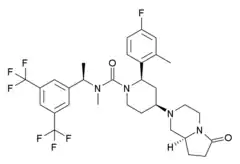 | |
| Clinical data | |
|---|---|
| ATC code |
|
| Identifiers | |
| |
| CAS Number | |
| PubChem CID | |
| ChemSpider | |
| UNII | |
| CompTox Dashboard (EPA) | |
| Chemical and physical data | |
| Formula | C31H35F7N4O2 |
| Molar mass | 628.636 g·mol−1 |
| 3D model (JSmol) | |
| |
| |
Orvepitant (GW823296) is a drug developed by GlaxoSmithKline which acts as a selective antagonist for the NK1 receptor.[1] It was under development as a potential antidepressant drug, and early stage human clinical trials showed it to have some antidepressant effects, though not with sufficient efficacy to justify further development for this application. It was however considered a successful proof of concept for NK1 antagonists as potential antidepressants, and efforts are continuing to find more potent compounds which might be more effective.[2]
References
- ↑ Di Fabio R, Alvaro G, Braggio S, Carletti R, Gerrard PA, Griffante C, et al. (November 2013). "Identification, biological characterization and pharmacophoric analysis of a new potent and selective NK1 receptor antagonist clinical candidate". Bioorganic & Medicinal Chemistry. 21 (21): 6264–73. doi:10.1016/j.bmc.2013.09.001. PMID 24075145.
- ↑ Ratti E, Bettica P, Alexander R, Archer G, Carpenter D, Evoniuk G, et al. (May 2013). "Full central neurokinin-1 receptor blockade is required for efficacy in depression: evidence from orvepitant clinical studies". Journal of Psychopharmacology. 27 (5): 424–34. doi:10.1177/0269881113480990. PMID 23539641. S2CID 6523822.
This article is issued from Wikipedia. The text is licensed under Creative Commons - Attribution - Sharealike. Additional terms may apply for the media files.